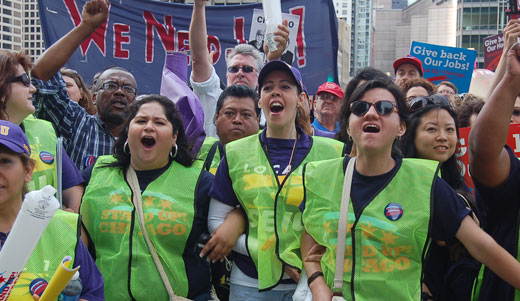
There are women who guide ships into outer space, women who lead nations, universities that compete for the attention of bright young women, and there are women who can choose to have both a family and a career.
Today, International Women’s Day 2012, is a day on which women around the world are hooking up at rallies, conferences, public events, parades and on the world-wide web to celebrate these achievements.
But the union folks and the labor movement that has done so much to make the aforementioned achievements possible are also marking the day by putting out front a disappointing statistic. They are hoping to turn the positive energy of International Women’s Day into a tool that will change that statistic.
The startling statistic that worldwide, women are paid at least 18 percent on average less than their male counterparts at work is in a new report released today by the International Trade Union Confederation.
The ITUC represents 175 million workers in 151 countries and territories and has 305 national affiliates.
“Frozen in Time: Gender Pay Gap Unchanged for 10 Years” examines women’s wages in 43 countries.
“For the last decade we have seen women’s wages hitting a road block,” declared Sharron Burrow, General Secretary of the ITUC. “The pay gap remains frozen in time almost everywhere.”
Burrow said the organized labor movement is a force that can make a difference, however.
“More unionized sectors such as the public sector tend to have lower pay gaps,” she said. She added, however, that “part of the problem is that many workers are not paid a decent minimum wage.”
Low minimum wages, particularly when seen in the context of recent Republican attacks on both unions and women’s rights in this country, help explain current negative trends regarding women’s wages in America.
The ITUC report points out that in the United States, the gender pay gap shrank dramatically from 38.7 percent in 1970 to below 19 percent in 2005. Since then the pay gap between men and women has widened again to nearly 20 percent, larger than the worldwide average.
The report also shows that while men profit more from an education than women in many countries, in the United States the statistics are really bad: Male workers age 30 or younger who have a middle level education make 48 percent more than women, and male workers age 30 or younger with a high level of education earn 37 percent more than women with the same education levels.
“The wage gap continues to be a problem for women workers, and even more for young women workers,” said Elizabeth Shuler, Secretary-Treasurer of the AFL-CIO. .
Shuler and other labor leaders here in the U.S. argue that Republican attacks on the labor movement, particularly on the right to organize and form unions, will have to be defeated and turned back in order for women to make progress in narrowing the wage gap.
“Given the positive effect unionization has on wages, it is more important now than ever, that young people, especially young women, have the opportunity to form unions,” Shuler said.
Photo: People’s World












Comments